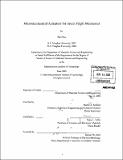| dc.contributor.advisor | Martin A. Schmidt. | en_US |
| dc.contributor.author | Zhou, Hui, M.S. Massachusetts Institute of Technology | en_US |
| dc.contributor.other | Massachusetts Institute of Technology. Dept. of Materials Science and Engineering. | en_US |
| dc.date.accessioned | 2009-01-30T16:32:11Z | |
| dc.date.available | 2009-01-30T16:32:11Z | |
| dc.date.copyright | 2008 | en_US |
| dc.date.issued | 2008 | en_US |
| dc.identifier.uri | http://hdl.handle.net/1721.1/44319 | |
| dc.description | Thesis (S.M.)--Massachusetts Institute of Technology, Dept. of Materials Science and Engineering, 2008. | en_US |
| dc.description | Includes bibliographical references (p. 95-97). | en_US |
| dc.description.abstract | This project aims to develop MEMS actuators to aid in the study of insect flight mechanics. Specifically, we are developing actuators that can stimulate the antennae of the crepuscular hawk moth Manduca Sexta. The possible mechanosensory function of antennae as airflow sensors has been suggested, and recent discoveries of our collaborators reveal that mechanosensory input from the antennae of flying moths serves a similar role to that of the hind wings of two-winged insects, detecting Coriolis forces and thereby mediating flight stability during maneuvers. Early evidence suggests that mechanical stimulus of the antennae may enable flight control. In addition, the crepuscular hawk moth Manduca Sexta has a wide wingspan (~110 mm) and is capable of carrying at least one quarter of its own weight. Thus, studying the flight of Manduca Sexta by attachment of microsystems seems plausible. The goal of our project is to design and fabricate micromechanical actuators, which will be mounted onto the moth antennae. Our collaborators will study the flight control mechanism by mechanical stimulation. Our first step was to fabricate "dummy" silicon rings for our biologist collaborators for implant experiment. A series of mounting kits were developed, and due to the nature of the moth antennae, ring-beam-ring construction was finally designed and fabricated, like a "shackle", to meet the mounting requirements. Next, we integrated actuators onto the mounting kit. Piezoelectric film/sheet, piezoelectricbender and piezoelectric-stack were considered as the actuators. Live testing was also taken while the moth was resting or flapping its wings. The moth apparently responds to the mechanical stimulus under both circumstances, by swinging its wings and abdomen. Actuation amplifier was also modeled and tested, which might be used for future mechanical stimulators. | en_US |
| dc.description.statementofresponsibility | by Hui Zhou. | en_US |
| dc.format.extent | 97 p. | en_US |
| dc.language.iso | eng | en_US |
| dc.publisher | Massachusetts Institute of Technology | en_US |
| dc.rights | M.I.T. theses are protected by
copyright. They may be viewed from this source for any purpose, but
reproduction or distribution in any format is prohibited without written
permission. See provided URL for inquiries about permission. | en_US |
| dc.rights.uri | http://dspace.mit.edu/handle/1721.1/7582 | en_US |
| dc.subject | Materials Science and Engineering. | en_US |
| dc.title | Micromechanical actuators for insect flight mechanics | en_US |
| dc.type | Thesis | en_US |
| dc.description.degree | S.M. | en_US |
| dc.contributor.department | Massachusetts Institute of Technology. Department of Materials Science and Engineering | |
| dc.identifier.oclc | 275170749 | en_US |
